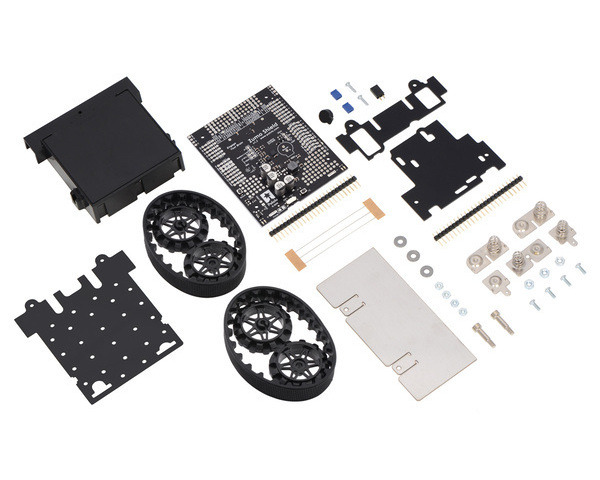

This is a merged information page for Item #2509.
View normal product page.
Pololu item #:
2509
Brand:
Pololu
Status:
Active

This kit contains most of the parts you need to build an Arduino-controlled Zumo robot. It consists of a Zumo Shield for Arduino, a Zumo chassis kit, and a Zumo blade. You will also need a pair of micro metal gearmotors, four AA batteries, and an A-Star 32U4 Prime or Arduino to complete your Zumo robot (motors, batteries, and Arduino sold separately). This product is a kit; assembly (including soldering) is required.
 Compare all products in Zumo Robot for Arduino or
Compare all products in Zumo Robot for Arduino or  Robot Kits with Soldering or
Robot Kits with Soldering or  Shields for Arduino.
Shields for Arduino.
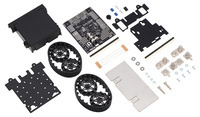 |
Contents of the Zumo robot kit for Arduino. |
|---|
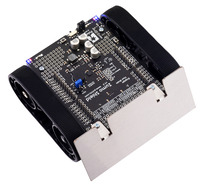 |
Zumo Robot for Arduino. |
|---|
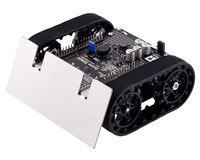 |
Zumo Robot for Arduino. |
|---|
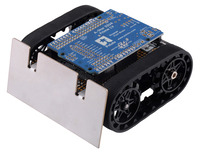 |
Assembled Zumo Robot for Arduino with an Arduino-compatible A-Star 32U4 Prime LV. |
|---|
 |
A Zumo 32U4 robot (left) and a Zumo robot for Arduino with an A-Star 32U4 Prime LV (right). |
|---|
Note: This product is a kit; assembly (including soldering) is required. Motors, batteries, and Arduino are sold separately. An assembled version is available that does not require any assembly or soldering and includes motors and a Zumo reflectance sensor array.
New inertial sensors! In September 2020, we started transitioning to shipping this kit with the v1.3 version of the Zumo Shield. The main difference is the new version replaces the shield’s inertial sensors with an LSM6DS33 accelerometer and gyro and an LIS3MDL magnetometer, as the LSM303D accelerometer and magnetometer used on the original revision has been discontinued. You can use our updated Zumo Shield Arduino library to help you write code that will work with the inertial sensors on either revision. In addition, the power switch and pushbuttons on the v1.3 shield have been changed to be surface-mount parts. For more information, see the user’s guide.
All units shipping now from Pololu have the newer v1.3 shield. If you require units with the previous v1.2 version, please contact us before you place your order.
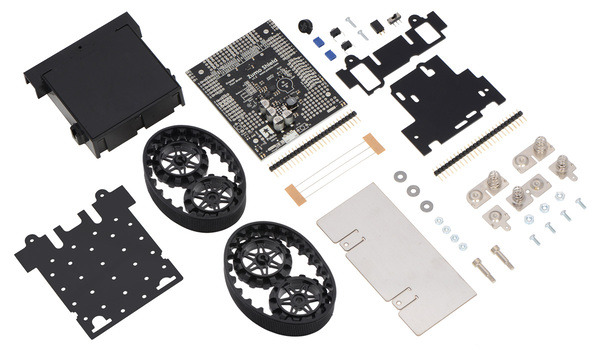 |
Contents of the Zumo robot kit for Arduino, v1.2. |
|---|
Please see the specific pages for those products for more information about them, assembly instructions, and links to related resources.
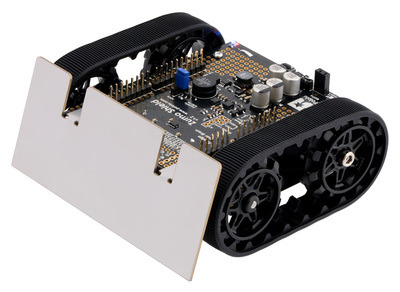 |
Zumo Robot for Arduino, v1.2. |
|---|
 |
Zumo chassis being assembled with two Micro Metal Gearmotor. |
|---|
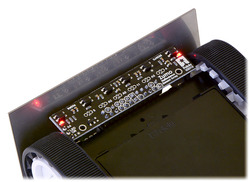 |
Zumo reflectance sensor array on a Zumo robot, bottom view. |
|---|
|
|
|
The newer Zumo 32U4 is another robot based on the Zumo chassis. It is a more highly integrated robot than the Zumo robot for Arduino, with enhancements that include a built-in Arduino-compatible ATmega32U4 microcontroller (the same one used in the Arduino Leonardo and A-Star 32U4 boards), an LCD, encoders for closed-loop motor control, and proximity sensors for obstacle detection. The Zumo 32U4 main board effectively combines the functions of the Zumo Shield and the separate Arduino controller into a single, compact board that is just as easy to program as a standard Arduino or A-Star thanks to its USB interface and preloaded Arduino-compatible bootloader.
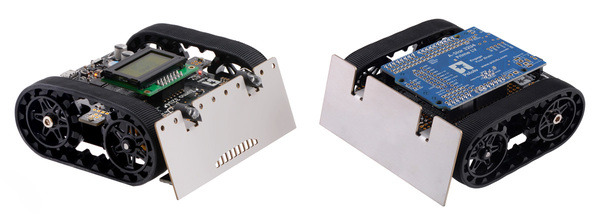 |
A Zumo 32U4 robot (left) and a Zumo robot for Arduino with an A-Star 32U4 Prime LV (right). |
|---|
Some of the pin mappings and software libraries differ between the Zumo 32U4 and Zumo robot for Arduino, so programs written for one robot generally need to be modified to work on the other.
User’s manual for the Pololu Zumo Shield for Arduino.
This model uses simplified models of the control electronics to reduce the file size. More detailed models are available separately of the Zumo shield for arduino, v1.3 (17MB step) and Zumo reflectance sensor array (5MB step).
This model uses simplified models of the control electronics to reduce the file size. More detailed models are available separately of the Zumo shield for arduino, v1.2 (13MB step) and Zumo reflectance sensor array (5MB step).
Un guide complet pour assembler, utiliser et exploiter rapidement votre Robot Zumo (version 0.1). Note: This French translation of our Zumo Robot for Arduino user’s guide was made by our distributor MCHobby.
This library and examples for Arduino-compatible boards makes it easy to program an Arduino-controlled robot built with Pololu’s Zumo Shield or Zumo robot kit (also available fully assembled).
This is a library for the Arduino that interfaces with our LSM303D, LSM303DLHC, and LSM303DLM 3D compass and accelerometer carriers as well as the compass and accelerometer ICs on the MinIMU-9 v3 and AltIMU-10 v4 (it also works with older versions of those boards, some of which used the LSM303DLH and LSM303DLHC). It makes it simple to configure the device and read the raw accelerometer and magnetometer data, and it has a function for computing the tilt-compensated heading for those looking to use the LSM303 as a tilt-compensated compass.
This is a library for the Arduino that interfaces with our L3GD20H and L3GD20 3-axis gyro carriers as well as the gyros on the MinIMU-9 v3 and AltIMU-10 v3 (it also works with older versions of those boards, some of which used the L3G4200D and the L3GD20). It makes it simple to configure the device and read the raw gyro data.
This library can be used to program an Arduino-controlled Zumo through MATLAB and Simulink. It provides driver blocks for all the sensors present on the Zumo Robot as well as example models showing their usage.
This tutorial on the Adafruit Learning System guides you through the process of programming a Zumo robot with Simulink.
This MicroPython library from Pololu distributor MC Hobby allows a MicroPython pyboard or Raspberry Pi Pico to control a Zumo Robot for Arduino. MC Hobby has adapter boards that let you easily connect either controller to the Zumo Shield. Documentation is available in both French and English.
This tutorial from Adafruit shows how to pair a Pixy CMUCam-5 vision system with the Zumo Robot for Arduino to enable it to chase objects or follow you around.
This article was written by Professor Erich Styger for his class on embedded systems programming at the Lucerne University of Applied Sciences and Arts. It describes various ways to tweak the performance of a Zumo to be more competitive in a Mini Sumo competition. Note that his Zumos use a custom PCB rather than our Zumo shield for Arduino; our shield has a lot of capacitance in parallel with the batteries that generally prevents the “battery inertia” problem Erich describes.
This is a YouTube playlist by control systems lecturer Brian Douglas that uses the L3GD20 MEMS gyroscope. It describes the fundamentals of the gyro and how to use it for closed and open loop control projects with MATLAB/Simulink and Arduino.
This robot is uses our Zumo robot kit, 75:1 micro metal gearmotors, and a Zumo reflectance sensor array. Instead of an Arduino it uses a Freescale FRDM-KL25Z as the microcontroller board, and sample code is available for line following and maze solving. By Erich, March 2013.
No FAQs available.
MCHobby, a Pololu distributor, translated the Pololu Zumo Shield for Arduino User’s Guide to French as the Guide utilisateur du Robot Zumo Pololu...
LVBots held a mini-sumo competition at Pololu on August 20. The goal of mini-sumo is to make an autonomous robot that pushes the other robot out...
We posted recently about how progress in MEMS sensors has resulted in a constant stream of improved Pololu breakout boards. This week, we brought...